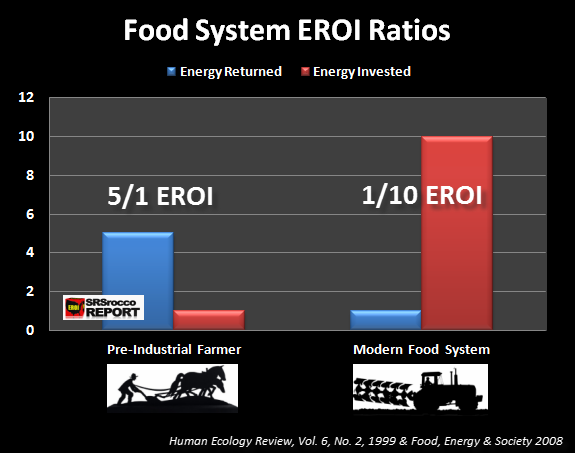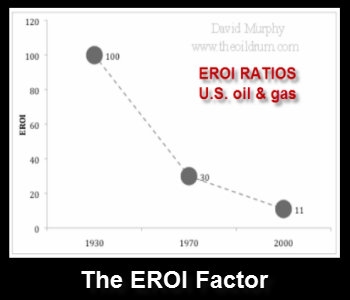There is a big misconception in the United States today that modern technology has made us more efficient in both industry and economy. For example, most of us who have driven down the U.S. Interstate Highway System have seen the huge farm tractors and combines working the soils of the Midwest. As we pass them, we tend to be amazed at how relatively small farming staffs can produce all that food with just the help of high-quality farm equipment. While these operations seem very efficient at first-glance, our perceptions are quite the opposite of reality.
How efficient the production of a particular good or service is, truly correlates with the amount of energy expended on its development. The EROI – Energy Returned on Invested— is an excellent indicator of the true nature of our efficiency in producing and using energy. Whether it is reflected in human-animal labor outputs or found in one of the various energy sources that we may tap into every day to produce goods and services, such as oil, coal, gas, etc, the EROI of a particular process is one in the same. This term has also been labeled as the EROEI (Energy Returned on Energy Invested). Both describe the same principle.
For instance, pre-industrial farming methods that utilize manual labor or horse and plow provide between 1-5 calories of energy (food) for every calorie of energy consumed in planting and harvesting. On the other hand, the modern high-tech food production industry, with a farmer sitting in an air-conditioned John Deere tractor that is guided by satellite tracking, consumes a staggering 10 calories of energy for every calorie of energy (food) delivered to the market.
The modern food production and distribution system now consumes ten times more energy than it provides. “In the know” scholars like Professors Kent Klitgaard of Wells College and Charles Hall of the SUNY College of Environmental Science and Forestry consider this flagrant mishandling of resources the Trojan horse of our times.**
Look carefully at the graph below:
The EROI of oil and gas, (especially in the U.S.), has been falling since the early 1930’s, which has now begun inflicting severe pressure on all sectors and industries in the economy. In 1930, the oil and gas industry could produce 100 barrels of oil for market for every barrel of energy cost. By 1970, production fell to a ratio of 30 to 1, and by 2000 it stood at just 11 to 1.
Basically, the falling EROI of oil & gas provides less net energy for the market. Thus, as net energy declines, prices rise due to the increased production costs found throughout the economy.
The SRrocco Report will explore and discuss how the falling EROI will impact the future economy as well as provide ideas on how to protect one’s wealth.
** See Hall and Klitgaard’s excellent resource, Energy and the Wealth of Nations: Understanding the Biophysical Economy


